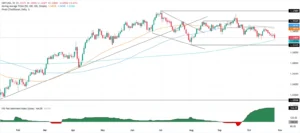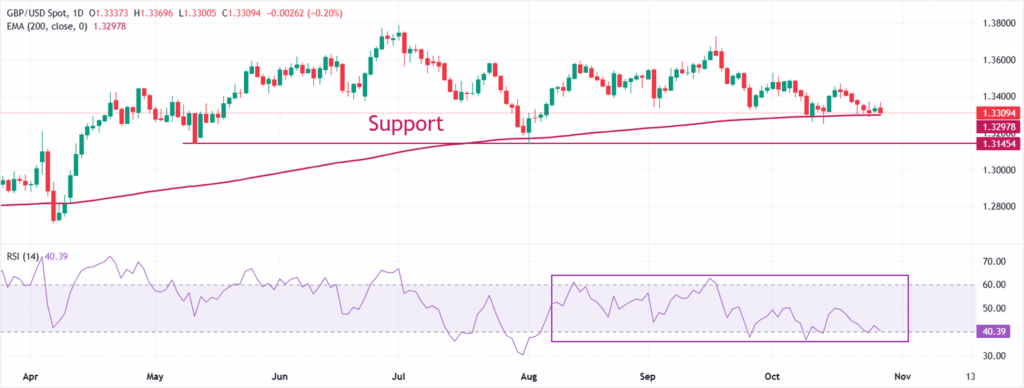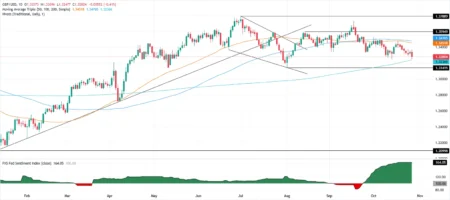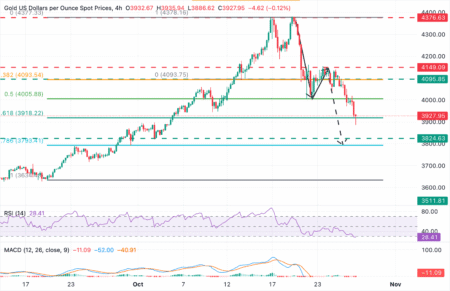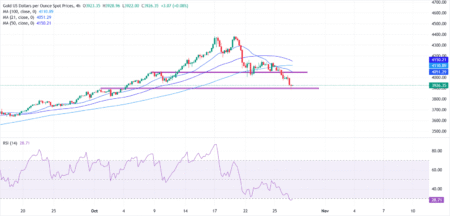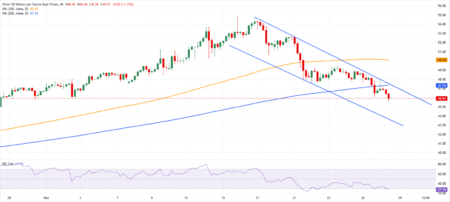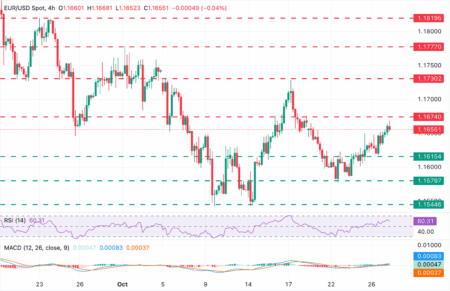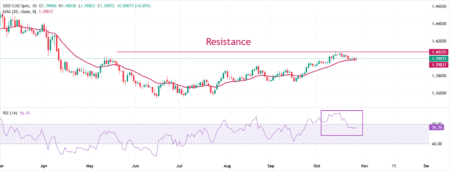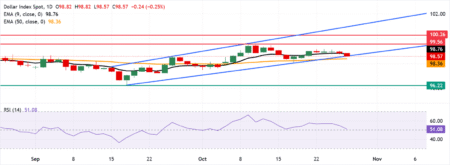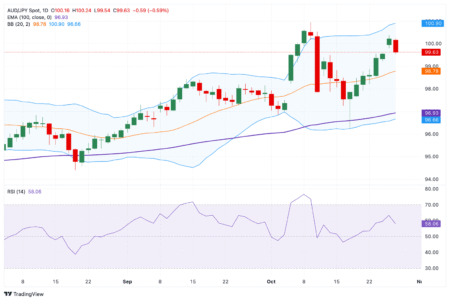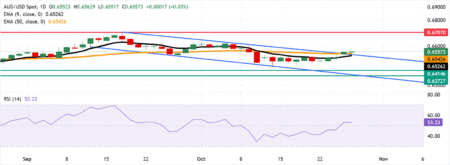The Pound Sterling (GBP) trades lower against its major currency peers on Tuesday. The British currency weakens as firming Bank of England (BoE) dovish bets offset the impact of improved global market sentiment
Hopes of the Bank of England (BoE) easing monetary conditions have increased as United Kingdom (UK) retailers have cut their prices in October. The British Retail Consortium (BRC) showed earlier in the day that overall shop prices dropped by 0.3% monthly from September, the first decline seen since March. Accelerating BoE rate cut expectations could weigh on the Pound Sterling in the near term.
During the European session, a Reuters poll shows that the BoE will not cut interest rates in the remainder of the year. The poll predicted that interest rates would decline to 3.75% by the first quarter of 2026. The poll also showed that the UK inflation could decline to 3.6% this quarter and average 2.5% in 2026 and 2.1% in 2027.
Meanwhile, the risk appetite of investors has increased due to growing expectations that the United States (US) and China will reach a trade deal soon.
On Monday, US President Donald Trump expressed confidence that a deal would be announced after his meeting with Chinese leader Xi Jinping later this week in South Korea.
“I’ve got a lot of respect for President Xi and I think we’re going to come away with a deal,” Trump said to reporters at Air Force One while traveling to Tokyo. Trump also expressed the possibility that he would visit China in early 2026.
Additionally, the optimism on the US-China trade deal was also prompted by comments from US Treasury Secretary Scott Bessent signaling that Washington will not proceed with 100% additional tariffs announced on Beijing. Bessent also expressed confidence that China will defer rare earth export controls, which propelled trade frictions between the world’s two largest economies.
Pound Sterling Price Today
The table below shows the percentage change of British Pound (GBP) against listed major currencies today. British Pound was the weakest against the Japanese Yen.
| USD | EUR | GBP | JPY | CAD | AUD | NZD | CHF | |
|---|---|---|---|---|---|---|---|---|
| USD | -0.11% | 0.20% | -0.55% | 0.04% | -0.03% | -0.08% | -0.11% | |
| EUR | 0.11% | 0.31% | -0.44% | 0.15% | 0.08% | 0.00% | -0.00% | |
| GBP | -0.20% | -0.31% | -0.71% | -0.16% | -0.23% | -0.28% | -0.32% | |
| JPY | 0.55% | 0.44% | 0.71% | 0.58% | 0.51% | 0.46% | 0.42% | |
| CAD | -0.04% | -0.15% | 0.16% | -0.58% | -0.08% | -0.12% | -0.16% | |
| AUD | 0.03% | -0.08% | 0.23% | -0.51% | 0.08% | -0.05% | -0.08% | |
| NZD | 0.08% | -0.00% | 0.28% | -0.46% | 0.12% | 0.05% | -0.03% | |
| CHF | 0.11% | 0.00% | 0.32% | -0.42% | 0.16% | 0.08% | 0.03% |
The heat map shows percentage changes of major currencies against each other. The base currency is picked from the left column, while the quote currency is picked from the top row. For example, if you pick the British Pound from the left column and move along the horizontal line to the US Dollar, the percentage change displayed in the box will represent GBP (base)/USD (quote).
Daily digest market movers: Pound Sterling surrenders early losses against US Dollar
- The Pound Sterling gives up early gains against the US Dollar (USD) and falls to near 1.3300 during the European trading session on Tuesday. The GBP/USD pair falls back as the Pound Sterling declines on easing consumer inflation expectations. Meanwhile, the US Dollar is also facing selling pressure amid firm expectations that the Federal Reserve (Fed) will cut interest rates in the monetary policy announcement on Wednesday.
- At the press time, the US Dollar Index (DXY), which tracks the Greenback’s value against six major currencies, trades 0.2% lower, near the weekly low of 98.60.
- Signs of moderate US inflation growth, weak job demand, and the ongoing federal shutdown are major reasons behind intensified Fed dovish expectations. The US Consumer Price Index (CPI) report for September showed on Friday that price pressures grew moderately on a monthly basis.
- Latest commentaries from a majority of Federal Open Market Committee (FOMC) members, including Chairman Jerome Powell, have warned about deteriorating US labor market conditions.
- “Downside risks to the US job market have risen, which also justified the September interest rate cut,” Powell said in a speech at the National Association for Business Economics (NABE) conference in the mid of this month.
- Meanwhile, the ongoing US government shutdown, which is entering its fourth week, has raised concerns over the economic outlook.
- Apart from the Fed’s interest rate decision, investors will also focus on cues regarding the monetary policy outlook for the remainder of the year. The Fed’s dot plot released at the September policy meeting showed that policymakers collectively see Federal Fund rates heading to 3.6% by the year-end, suggesting that the US central bank will cut rates again in December’s meeting.
Technical Analysis: Pound Sterling struggles to hold 200-day EMA
The Pound Sterling struggles to hold the key support around 1.3300 against the US Dollar on Tuesday. The overall trend of the GBP/USD pair is uncertain as it wobbles near the 200-day Exponential Moving Average (EMA), which trades around 1.3300.
The 14-day Relative Strength Index (RSI) wobbles near 40.00. A fresh bearish momentum would emerge if the RSI drops below that level.
Looking down, the August 1 low of 1.3140 will act as a key support zone. On the upside, the psychological level of 1.3500 will act as a key barrier.
Economic Indicator
Fed Interest Rate Decision
The Federal Reserve (Fed) deliberates on monetary policy and makes a decision on interest rates at eight pre-scheduled meetings per year. It has two mandates: to keep inflation at 2%, and to maintain full employment. Its main tool for achieving this is by setting interest rates – both at which it lends to banks and banks lend to each other. If it decides to hike rates, the US Dollar (USD) tends to strengthen as it attracts more foreign capital inflows. If it cuts rates, it tends to weaken the USD as capital drains out to countries offering higher returns. If rates are left unchanged, attention turns to the tone of the Federal Open Market Committee (FOMC) statement, and whether it is hawkish (expectant of higher future interest rates), or dovish (expectant of lower future rates).
Read more.
Next release:
Wed Oct 29, 2025 18:00
Frequency:
Irregular
Consensus:
4%
Previous:
4.25%
Source:
Federal Reserve
Read the full article here




